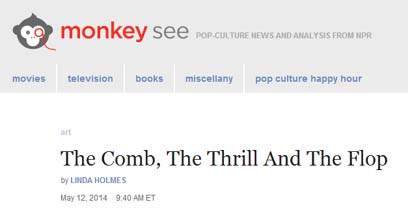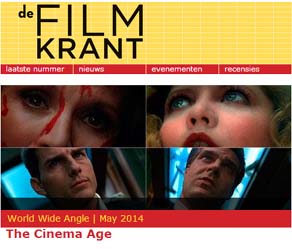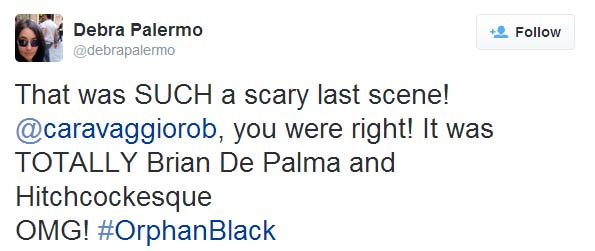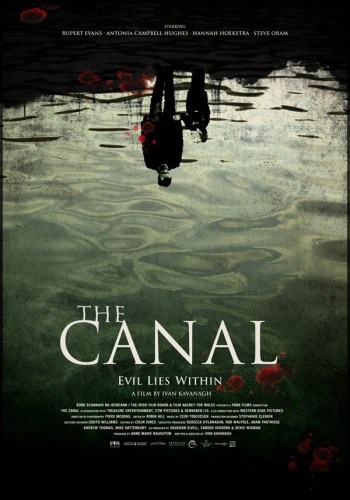

 Hello and welcome to the unofficial Brian De Palma website. Here is the latest news: |
|---|
E-mail
Geoffsongs@aol.com
-------------
Recent Headlines
a la Mod:
Listen to
Donaggio's full score
for Domino online
De Palma/Lehman
rapport at work
in Snakes
De Palma/Lehman
next novel is Terry
De Palma developing
Catch And Kill,
"a horror movie
based on real things
that have happened
in the news"
Supercut video
of De Palma's films
edited by Carl Rodrigue
Washington Post
review of Keesey book
-------------
Exclusive Passion
Interviews:
Brian De Palma
Karoline Herfurth
Leila Rozario
------------
------------
| « | May 2014 | » | ||||
| S | M | T | W | T | F | S |
| 1 | 2 | 3 | ||||
| 4 | 5 | 6 | 7 | 8 | 9 | 10 |
| 11 | 12 | 13 | 14 | 15 | 16 | 17 |
| 18 | 19 | 20 | 21 | 22 | 23 | 24 |
| 25 | 26 | 27 | 28 | 29 | 30 | 31 |
De Palma interviewed
in Paris 2002
De Palma discusses
The Black Dahlia 2006

Enthusiasms...
Alfred Hitchcock
The Master Of Suspense
Sergio Leone
and the Infield
Fly Rule
The Filmmaker Who
Came In From The Cold
Jim Emerson on
Greetings & Hi, Mom!
Scarface: Make Way
For The Bad Guy
Deborah Shelton
Official Web Site
Welcome to the
Offices of Death Records
 Variety's Leo Barraclough reports from Cannes today that Brian De Palma is among several filmmakers who will appear as interviewees in the upcoming feature documentary Hitchcock/Truffaut, which looks at the book of the same name and is based on the recordings (of Alfred Hitchcock discussing his career with Francois Truffaut) that led to its completion. Kent Jones is directing the movie, which will be released in 2015. It will also include interviews with Martin Scorsese, Steven Spielberg, Wes Anderson, David Fincher, James Gray, Richard Linklater, Luc and Jean-Pierre Dardenne, Olivier Assayas, and Arnaud Desplechin. Barraclough reports that "the directors will share how the book shaped their careers, transformed cinema and introduced the French New Wave and 'New Hollywood' to the world."
Variety's Leo Barraclough reports from Cannes today that Brian De Palma is among several filmmakers who will appear as interviewees in the upcoming feature documentary Hitchcock/Truffaut, which looks at the book of the same name and is based on the recordings (of Alfred Hitchcock discussing his career with Francois Truffaut) that led to its completion. Kent Jones is directing the movie, which will be released in 2015. It will also include interviews with Martin Scorsese, Steven Spielberg, Wes Anderson, David Fincher, James Gray, Richard Linklater, Luc and Jean-Pierre Dardenne, Olivier Assayas, and Arnaud Desplechin. Barraclough reports that "the directors will share how the book shaped their careers, transformed cinema and introduced the French New Wave and 'New Hollywood' to the world.""For me, in many ways, cinema began with Francois Truffaut’s book about Alfred Hitchcock,” Jones tells Barraclough. “For me, and for many others, the book was more than formative — it was essential and direct.”
The book, of course, made a cameo in De Palma's Greetings (as shown above).
 RogerEbert.com published an excerpt today about Brian De Palma from David Greven's book, Psycho-Sexual. Here's the closing paragraph of the excerpt:
RogerEbert.com published an excerpt today about Brian De Palma from David Greven's book, Psycho-Sexual. Here's the closing paragraph of the excerpt:
 In a "Monkey See" essay for NPR, Linda Holmes discusses three pop culture activities she experienced last weekend, including reading Julie Salamon's The Devil's Candy, which details the making of Brian De Palma's The Bonfire Of The Vanities. One of the other two activities involved spending about five hours on Saturday at the Metropolitan Museum Of Art with a rented audio guide unit. The third is described by Holmes at the beginning of this excerpt from her essay:
In a "Monkey See" essay for NPR, Linda Holmes discusses three pop culture activities she experienced last weekend, including reading Julie Salamon's The Devil's Candy, which details the making of Brian De Palma's The Bonfire Of The Vanities. One of the other two activities involved spending about five hours on Saturday at the Metropolitan Museum Of Art with a rented audio guide unit. The third is described by Holmes at the beginning of this excerpt from her essay:At the museum, there is an ivory comb from the Egyptian Predynastic Period. Roughly 3200 B.C., they say. They suggest it might have been part of the accoutrements of someone's funeral more than 5000 years ago; more than 20 times the entire history of the country the museum is housed in. More than 115 times as long as I've been alive. The teeth of the comb are broken off; what remains is a little more than two inches tall and a little less than two inches wide, and those four square inches hold more than 20 individual renderings of animals. The carvings have symbolic significance, but they're also carefully and elegantly done, particularly on a piece so small. The comb played a role, perhaps, in an important ritual, but it's also a beautiful object, like many of the drums and bowls and pieces of blown glass.
The piece was, then, meant to be an offering of the artist's skills, to convey a meaning, to evoke an emotion, and to bring pleasure. So was The Bonfire Of The Vanities. So was The Thrilling Adventure Hour.
Those aren't the only purposes to which these other works are being put: the film was also engineered to make money, of course, perhaps cripplingly so. The live show, while far less damned by its relationship to commerce, is part of the performers' livelihoods particularly in the broad sense, since many of them remain people whose projects might well be described using, at some point, the word "cult." It supports you, the cult, but only sometimes does it keep you in food and shelter. And it demands to be fed in return, of course.
The Bonfire Of The Vanities didn't just aspire to keep people in food and shelter; it aspired to keep people in mansions and private planes. What it doesn't have that The Thrilling Adventure Hour has is an animating love of the material. Everyone involved seemed to have assumed Wolfe's book was capital-G Great, whether or not they had read it, but they began excising its controversial elements – which in this case meant its essential elements – almost immediately. There was so much money, there were so many trailers, there was so much fake rain, there were so many gowns and extras ... but the way Salamon tells the tale, few of them were – maybe nobody was – there for love.
 Le Grand Action in Paris is featuring a Vilmos Zsigmond retrospective this month ("Vilmos Zsigmond passe à l'action") that began May 10 and 11 with the two films he shot for Michael Cimino, The Deer Hunter and Heaven's Gate. In all, eleven of the cinematographer's films will be screened: the two Ciminos, both films he made with Richard Donner (Maverick and Assassins), the four that he's made with Brian De Palma (Obsession, Blow Out, The Bonfire Of The Vanities, and The Black Dahlia), and the three that he's made with Woody Allen (Melinda & Melinda, Cassandra's Dream, and You Will Meet A Tall Dark Stranger).
Le Grand Action in Paris is featuring a Vilmos Zsigmond retrospective this month ("Vilmos Zsigmond passe à l'action") that began May 10 and 11 with the two films he shot for Michael Cimino, The Deer Hunter and Heaven's Gate. In all, eleven of the cinematographer's films will be screened: the two Ciminos, both films he made with Richard Donner (Maverick and Assassins), the four that he's made with Brian De Palma (Obsession, Blow Out, The Bonfire Of The Vanities, and The Black Dahlia), and the three that he's made with Woody Allen (Melinda & Melinda, Cassandra's Dream, and You Will Meet A Tall Dark Stranger).
 Adrian Martin has written a "World Wide Angle" piece for Film Krant that takes off from the blind spots that are inevitable in "Greatest Films" lists. "Whenever my eye falls upon yet another 'Greatest Films of All Time' list," Martin begins, "I think about the filmmakers — undoubtedly fine and significant filmmakers — who, on most occasions, do not come within a million miles of being deified by such exercises in canon-making. They get chopped off the list very early in the cull. Brian De Palma, Mario Bava, John Carpenter, Dario Argento, William Friedkin, even Sergio Leone: just a few of the directors (all of us can name many more) who have given us works that we enjoy, teach, analyse, write about and cherish."
Adrian Martin has written a "World Wide Angle" piece for Film Krant that takes off from the blind spots that are inevitable in "Greatest Films" lists. "Whenever my eye falls upon yet another 'Greatest Films of All Time' list," Martin begins, "I think about the filmmakers — undoubtedly fine and significant filmmakers — who, on most occasions, do not come within a million miles of being deified by such exercises in canon-making. They get chopped off the list very early in the cull. Brian De Palma, Mario Bava, John Carpenter, Dario Argento, William Friedkin, even Sergio Leone: just a few of the directors (all of us can name many more) who have given us works that we enjoy, teach, analyse, write about and cherish."What really matters is your encounter, at some key moment of your developmental biography, with the work of a particular director. So there is a De Palma Age (for example) in the autobiographies of many of us — just as there is, for instance, a David Bowie Age or a Sylvia Plath Age or a Philip K. Dick Age.
Several generations of cinephiles and aspiring filmmakers have received a thrilling, formative sense of what cinema can be from the bracing experience of seeing, for the first time, Carrie (1976), Dressed to Kill (1980), Blow Out (1981), Carlito's Way (1993) and Femme Fatale (2002). It does not matter whether you were 15 years old in 1976 or 20 years old today, whether it's a Cinémathèque screen or a laptop: that formative thrill is the same.
Discovering a De Palma movie for the first time, soaking up its elaborate formal conceits, is to have one's eyes opened by boundlessly inventive tricks with time, space, narrative and perspective. Cinema is more than De Palma, but anyone can start to discover cinema through De Palma, as many of us have. And that is no bad thing.
It also does not matter if, later in life, we convince ourselves that we may have grown beyond what could be described, in retrospect, as an adolescent passion: it has lodged in there, inside of us, helped to form our sensibilities. And De Palma is one of the great sensibility-shapers of modern cinema.


Graeme Manson, co-creator of Orphan Black, tells Entertainment Weekly's Dalton Ross that a creepy scene in the latest episode (which aired Saturday) was an "homage to Carrie, all the way. The director did a great job with that scene and it’s right up the alley of what John Fawcett and I really like. It really slips into horror mode there and we like that the show has that elastic tone that we can do that...It’s a truly freaky and wonderful scene." I left some of what he said out of there, and do be warned that if you go to the EW article linked to above, it is full of spoilers.
The creators aren't the only ones from Orphan Black who are fans of Carrie. Last month, actor Jordan Gavaris, who plays Felix Dawkinson the show, told the San Francisco Chronicle's David Wiegand that he fell in love with movies when he worked at Blockbuster at the age of 15. "I got 10 free rentals a week," he laughed to Wiegand. "Before 15, you're seeing all the blockbusters. But then I saw (Brian De Palma's) Carrie. It was a phenomenal film, and I am obsessed with Sissy Spacek. I watched her entire filmography and what that did was expose me to directors like Robert Altman, Todd Field, Costa-Gavras, Michael Apted."
 The Canal, a psychological horror film written and directed by Ivan Kavanagh, was mostly well-received when it premiered at the Tribeca Film Festival last month (check out reviews at Fangoria, PopMatters, and the less enthusiastic This Is Infamous). The Canal is about a film archivist, and Kavanagh explains to Complex's Matt Barone that since the character's job is watching films, it makes perfect sense that his hallucinations and/or fantasies should be colored by those films. "For me," Kavanagh tells Barone, "it was the perfect opportunity to reference the films I love, to make a film that at moments seems like a Dario Argento film and at other moments like a different directors' films. It seemed right for the character. The film is about cinema, in a way. I don't usually do that referential thing in my films, but it just fit here. And a lot of them are unconscious. If you love the genre and love certain films in it, you can't help but be influenced by them. Another one we looked at a lot for this film was Nicolas Roeg's Don't Look Now, specifically for that film's look. We use a lot of zooms and lenses that are directly influenced by Don't Look Now. We put a lot of thought into everything. The best horror films, for me, are always divisive. Like with Argento, I don't love all of his stuff but I do love Suspiria. Films like that are so divisive—people either love them or violently hate them. That's the perfect type of film."
The Canal, a psychological horror film written and directed by Ivan Kavanagh, was mostly well-received when it premiered at the Tribeca Film Festival last month (check out reviews at Fangoria, PopMatters, and the less enthusiastic This Is Infamous). The Canal is about a film archivist, and Kavanagh explains to Complex's Matt Barone that since the character's job is watching films, it makes perfect sense that his hallucinations and/or fantasies should be colored by those films. "For me," Kavanagh tells Barone, "it was the perfect opportunity to reference the films I love, to make a film that at moments seems like a Dario Argento film and at other moments like a different directors' films. It seemed right for the character. The film is about cinema, in a way. I don't usually do that referential thing in my films, but it just fit here. And a lot of them are unconscious. If you love the genre and love certain films in it, you can't help but be influenced by them. Another one we looked at a lot for this film was Nicolas Roeg's Don't Look Now, specifically for that film's look. We use a lot of zooms and lenses that are directly influenced by Don't Look Now. We put a lot of thought into everything. The best horror films, for me, are always divisive. Like with Argento, I don't love all of his stuff but I do love Suspiria. Films like that are so divisive—people either love them or violently hate them. That's the perfect type of film."Kavanagh discusses more of his inspirations with the Hollywood Reporter's Matt Patches.
 The current issue of Fangoria (#332, May 2014) features what the cover bills as "Sex and Death in 1980: Dressed To Kill and Cruising." Inside are two separate articles about each respective film. The Dressed To Kill article by Lee Gambin and Camilla Jackson, titled "Murder Most Mod," is an interview with Nancy Allen and Keith Gordon, in which they discuss working on the movie together. Allen talks about how Brian De Palma, her husband at the time, would write in the morning, and when she would get up and get a cup of coffee, he would read to her "his current installment." She was initially excited about it, but later became nervous when she realized how much of the movie she would be carrying by herself, in contrast to the ensemble work she'd done on De Palma's Carrie.
The current issue of Fangoria (#332, May 2014) features what the cover bills as "Sex and Death in 1980: Dressed To Kill and Cruising." Inside are two separate articles about each respective film. The Dressed To Kill article by Lee Gambin and Camilla Jackson, titled "Murder Most Mod," is an interview with Nancy Allen and Keith Gordon, in which they discuss working on the movie together. Allen talks about how Brian De Palma, her husband at the time, would write in the morning, and when she would get up and get a cup of coffee, he would read to her "his current installment." She was initially excited about it, but later became nervous when she realized how much of the movie she would be carrying by herself, in contrast to the ensemble work she'd done on De Palma's Carrie.The pair discuss working with Michael Cain, Dennis Franz, and Angie Dickinson, who was still working on TV's Police Woman at the time, and would fly in to do her scenes. Whereas Allen and Gordon had plenty of rehearsal time, Dickinson did not. "Angie was finding her movie-acting rhythm again, and that was interesting to watch," Gordon tells Fangoria. "We did that one scene we had and we didn't rehearse it to death, so that was good. I was always trying to make her more comfortable by getting her to laugh and whatnot, and at first she didn't seem to like that, but she slowly warmed to it. Brian would tell her, 'Look, we're not trying to rush through eight pages a day, we can take our time.' and she relaxed into that. You could see that she remembered liking doing movies and having time, unlike TV where everything is bam-bam, real fast."
Allen talks about meeting Dickinson on set: "Angie and I met in the elevator and then said goodbye; it was like 'Hello! And goodbye!' all in one shot! I didn't have to use too much imagination for that scene; it was all there in front of me. All that blood and gore! But of course, it was also very technical. My hand had to be in this place and my eyes had to be there, and it all works because it's so brilliantly edited."
Fangoria then follows up: "The technicality of the shoot in general must have been very complex, with all the cuts, split screens, dissolves and so forth. Did that highly stylized direction dictate your performances in any way?"
Allen responds, "So much of it was all about timing. It felt robotic at times. For instance, at the end, with the shot first of Keith, then of Michael, then of me, everything had to be perfectly timed and cued up. So I would be doing strange things, and sometimes feeling rather awkward."
'UNDER THE SKIN'
There's a lot more to check out in the Dressed To Kill article, and other terrific articles in the magazine, including the cover story interview with Jonathan Glazer about Under The Skin. At the end of that interview, Fangoria's Chris Alexander tells Glazer, "We're putting Under The Skin on the cover of the most widely read horror-film magazine in the world. Many might not consider it a horror movie, but we do."
Glazer replies, "That's interesting. How does it fit into the canon of horror cinema for you?"
FANG's Alexander: "Horror has always concerned the everyday somehow transformed into a place of danger. It's about that sense of dread, of nightmarish ambiguity. No questions are answered at the end of Under The Skin, and it's haunting. Its effect lingers. To me, that's a horror film."
Glazer: "Great. Then I'm honored that it is. If that's what it is to you, if that's how it feels to you, then that's fantastic."